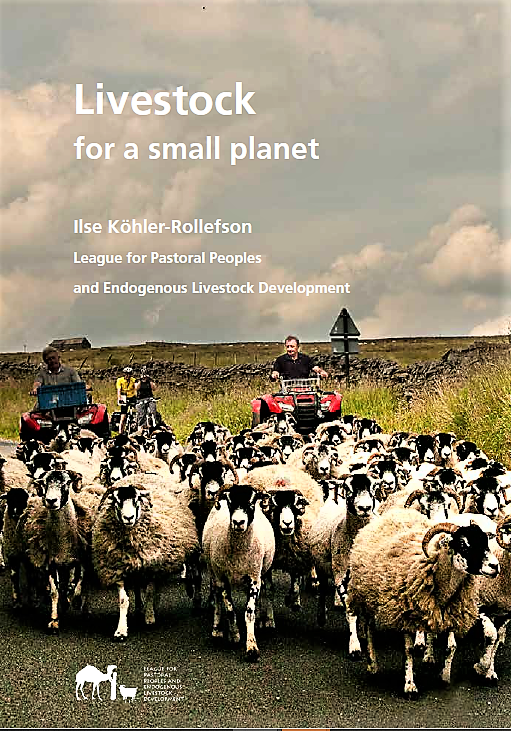
Judith Schwartz is one of the few environmental journalists who recognize the importance of livestock for the health of the planet. She is author of the classic Cows Save the Planet, and more recently of Reindeer Chronicles. I am delighted to share her review of ‘Livestock for a Small Planet‘, originally published in the latest edition of Pastoral Times (a highly recommendable broadsheet about happenings in the pastoral world that currently comes free of charge into your inbox).
Ilse Köhler-Rollefson’s timely and compelling report is an homage to Frances Moore Lappé’s 1971 book Diet for a Small Planet, which places food at the center of social justice and calls attention to the ecological cost of industrial meat production and consumption. In the five decades since that book’s publication, the world has gotten yet smaller, thanks to the Internet, more accessible travel, and increasingly opaque global supply chains. In addition, livestock—the heartbeat of traditional cultures throughout the world and integral to the livelihood of a billion-plus people—have become vilified and blamed for crises from water shortages to climate change. Köhler-Rollefson’s succinct, readable book directly takes on widespread misunderstandings about animal agriculture and shows how nature-aligned livestock stewardship can sustain people and planet. At a time when anti-livestock rhetoric has reached a treble pitch (to wit: with world leaders at this month’s COP26 climate summit urged to forego meat) Köhler-Rollefson’s cogent, clear-eyed account is a powerful corrective.
Rather than getting mired in well-trodden arguments, the author offers a fresh angle on animal-land dynamics informed by decades of observing pastoral practices. For example, she points out that nature has designed plants to be stationary and animals to be on the move. Under modern, industrial management, however, animals are kept in place while plants are cultivated as commodity feedstock and delivered to livestock, a system that involves shipping goods around the world. The health of the land, the animals, and the people who consume animal products all suffer as a consequence. This plant-animal “role reversal”, she writes, transforms a system based on solar energy into one totally dependent on fossil fuels. Highlighting the folly of manipulating nature to conform to markets cuts through squabbles about the need to intensify production in order to feed the world.
Köhler-Rollefson brings in the perspective of pastoralists, whose voices are often missing in policy discussions. Conversations about livestock tend to betray Western ethnocentrism, she says. She makes the point that we humans evolved in tandem with the animals we raise, and stresses the deep knowledge that herding cultures have built over time. If we lose these animals and traditional herding ways, she suggests, we lose a part of ourselves.
The book is divided into two distinct sections. The first zeroes in on nine common myths about livestock. This format allows the author to effectively counter misinformation and bring facts to what has become an emotional topic. She points out that rather than undermining food production by “taking up too much land”, livestock thrive in landscapes that are unsuited for crop agriculture. At a moment when many in western countries see livestock as climate villains and meat eating as unethical, Köhler-Rollefson makes the distinction between industrial management, which is environmentally destructive and cruel to animals, and pastoral systems, which regenerate dryland environments and afford animals better lives than in the wild.
The author takes on the fraught topic of greenhouse gas emissions, emphasizing the distinction between methane, a short-lived gas generated by the breaking down of plant material, and carbon dioxide, which remains in the atmosphere indefinitely. As she acknowledges, this is a complex matter and the focus of much fuzzy “cows-are-bad” math. She correctly says that regenerative grazing can build carbon in soils, thereby absorbing atmospheric CO2, and mentioned the high-profile example of ranch-owner and one-time US presidential candidate Tom Steyer. She could have noted, however, that restorative livestock rearing is more than a quirky California trend, as grassland restoration via holistic grazing is a rapidly growing, worldwide movement. For example, Savory Global now has training hubs in twenty countries and has developed land-to-market meat, dairy, wool, and leather supply chains based on ecological monitoring protocols. This underscores the increased awareness of grazing solutions and the wealth of potential alliances for pastoral communities.
One small quibble is the author’s parenthetical remark that grasslands require occasional burning. This is not true of all grassland ecosystems. What is necessary is a means of breaking down senescent vegetation. As Allan Savory points out, this process can occur chemically, through fire, or biologically, via the digestion of ruminant animals. While fire emits particulates and greenhouse gases and leaves bare soil, grazing sustains moisture and promotes more life on the land. It is important to acknowledge that herbivores represent an alternative to fire as well as a factor in fire resilience.
The second part articulates a vision for livestock management that aligns with nature and the needs of herding societies. The author challenges the assumption that we should intensify animal production, saying that what we actually need is to extensify livestock herding so that more plant waste material can be “upcycled” to protein-rich food and more land benefits from regenerative animal impact. She highlights the value of heritage breeds suited to specific locales and the need to empower small-scale farmers and herders. This part, a blueprint for a just, ethical, and regenerative livestock future, is essential reading,: a manifesto for human-animal partnership on a resource-stressed planet.
“Livestock for a Small Planet” extends a hand to readers familiar with problems linked to modern animal agriculture but may not be aware of alternatives—or that pastoral cultures have much to teach us. In all, Ilse Köhler-Rollefson does a wonderful job in showing the role livestock play in making our small planet go round.

 Follow
Follow